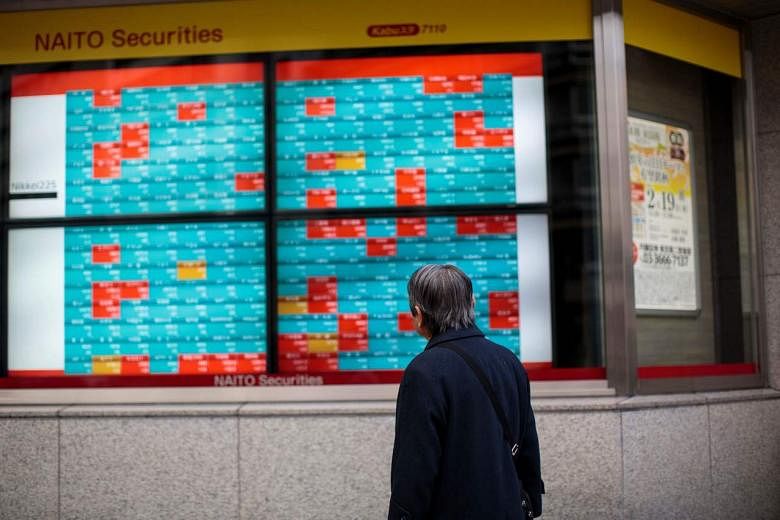SYDNEY (REUTERS) - Asian shares were under water on Friday (Feb 21) as fears over the creeping spread of the coronavirus sent funds fleeing to the sheltered shores of US assets, lofting the US dollar to three-year highs.
Even Wall Street turned soggy late on Thursday on news of increased infections in Beijing and abroad. South Korea reported 52 new confirmed cases on Friday.
Corporate earnings are increasingly under threat as US manufacturers, like many others, scramble for alternative sources as China's supply chains seize up.
The International Air Transport Association (IATA) estimated losses for Asian airlines alone could amount to almost US$28 billion this year, with most of that in China.
"Covid-19 anxiety has risen to a new level amid concerns of virus outbreaks in Beijing and outside of China," said Rodrigo Catril, a senior FX strategist at NAB.
"US and EU equity markets have been sold across the board with core global yields benefiting from safe-haven flows," he added. "Asian currencies have suffered sharp falls, including the yen as recession fears trump the usual safe-haven demand."
Adding to the tension was the imminent release of flash manufacturing surveys for a range of countries. Japan's index dropped to 47.6 in February, from 48.8, marking the steepest contraction in seven years.
Gold shined as a safe harbour and rose to its highest in seven years. The yellow metal was last at US$1,623.94 having added 2.5 per cent for the week so far.
Equities lagged badly, with MSCI's broadest index of Asia-Pacific shares outside Japan off 0.8 per cent on Friday in nervous trade.
South Korea slid 1.2 per cent as the virus spread in the country, while Japan's Nikkei eased 0.3 per cent even as a plunge in the yen promised to aid exporters.
Shanghai blue chips were holding their nerve thanks to the promise of more policy stimulus at home. But both E-Mini futures for the S&P 500 and EUROSTOXX 50 slipped 0.3 per cent.
The Dow had lost 0.44 per cent on Thursday, while the S&P 500 lost 0.38 per cent and the Nasdaq 0.67 per cent.
BUYING BONDS
Sovereign bonds benefited from the mounting risk aversion, with yields on 30-year US Treasuries falling below the psychologically important 2 per cent level to the lowest since September 2019.
Yields on 10-year notes were down 8 basis points for the week at 1.50 per cent, lows last seen in September.
"The US 10-year has rallied more than all the other liquid G5 bond market alternatives," said Alan Ruskin, global head of G10 FX strategy at Deutsche Bank.
"Treasuries attract foreign bond inflows because of their higher yields, and because higher yields leave more scope for yields to decline."
Those flows were a boon to the US dollar, boosting it to multi-month peaks against a raft of competitors this week.
The most spectacular gains came on the Japanese yen as a run of dire domestic data stirred talk of recession there and ended months of stalemate in the market.
The dollar was last lording it at 112.02 yen and set for its best week since September 2017 with a rise of 2 per cent. Another casualty of its close trade ties with China was the Australian dollar, which plumbed 11-years lows.
The euro fared little better, touching lows last seen in April 2017 to be trading at US$1.0787.
Against a basket of currencies, the dollar hit a three-year top at 99.910 having climbed 0.8 per cent for the week so far.
Analysts at RBC Capital Markets noted the dollar's outperformance had brought it close to breaching a host of major chart barriers, which could supercharge its rally.
"This has allowed the DXY to approach the 100.00 threshold - with a key resistance hurdle at 100.30 now within sight," they wrote in a note. The same went for the Chinese yuan.
"USD/CNH is now poised to pierce resistance at 7.0559 after the USD hit new cycle highs against other EM currencies."
Oil prices faded a little on Friday, but were still up more than 3 per cent for the week.
US crude dipped 38 cents to US$53.50 a barrel, while Brent crude futures eased 39 cents to US$58.92.











